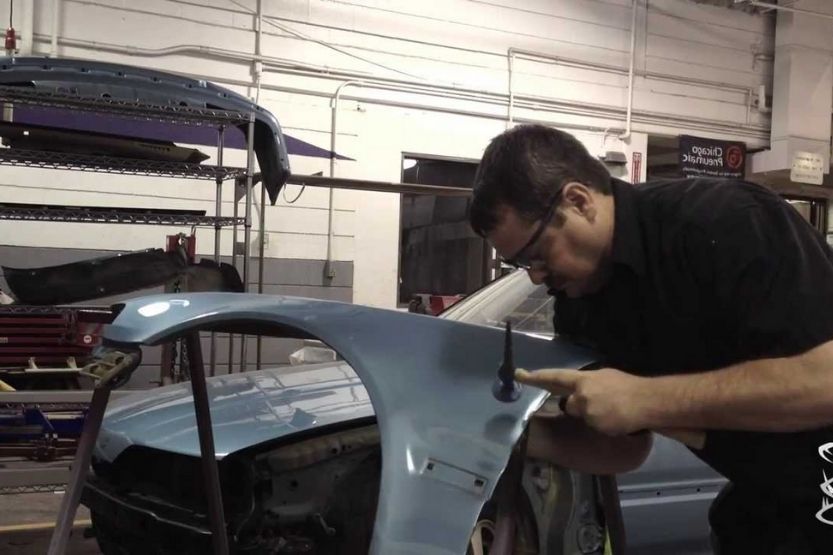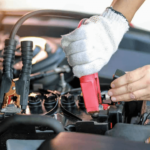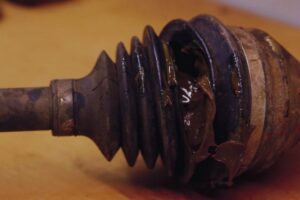A fender is a requirement for all cars and trucks. These fenders are there for important reasons and not just for coverings. What is a fender of a car – fender car part explained?
A fender is the part of a car, truck, motorcycle, or other vehicles that frames or covers a wheel well. Its main purpose is to prevent debris, rocks, mud, liquids, sand, and other road debris from getting thrown in the air while the tires rotate.
The “fender” typically refers to the front panel that covers the front wheels, and the “quarter panel” typically refers to the rear panel that covers the wheel that also includes the roof pillar. The “bumper” is the front and rear ends of a motor vehicle to absorb impact in a minor collision.
The below image shows a fender and quarter panel on a car. The top half of the image is the fender or “front fender” (highlighted in red). The bottom half of the image shows the quarter panel or “rear fender” (highlighted red).

Read on to learn more about fenders, what they are, why they are important, how to repair or replace them, and other related information that you need to know about them.
What Is a Fender on a Car? [Fender Car Part Explained]

The fender car part is the body kit or body part installed on the left and right sides of the vehicle. Manufacturers usually attach fenders to the wheel arches. There are different reasons why they are a requirement in vehicles. One obvious reason is to improve the aesthetics of the vehicle.
Fenders also enhance the car’s aerodynamics. They also prevent mud, sand, rocks, liquid, and all sorts of debris from being thrown in the air while you’re driving your car.
In the United States, the fender refers to the vehicle body part that frames or covers the wheel well. The wheel well is the space of a truck or car located under the fender. It is where the wheel has space to turn.
Typically in the US, fenders are those located at the front wheels. Aside from cars, they are also present on other vehicles, including trucks, motorcycles, and other vehicles. These panels are mainly called fenders because they are used to literally fend off the attack of all kinds of road debris.
This body part was given a name that describes its intended purpose quite well, not just how they look. Fenders actually guard the vehicle against the different types of debris that fly off from the road. They are just that – “defenders of road debris.”
Primary Function of Fender
The main purpose why there are fenders on cars is that they shield the wheels and they protect the passengers, the pedestrians, and the other vehicles from stones, mud, liquid, and other debris that can fly in the air because of the speeding rotating wheels while the car is running.
Fenders Should Have a Firm and Rigid Material
To provide this kind of protection, fenders should have a firm and rigid material such as steel. If you use your car every day on rough roads, it will experience a continuous “attack” of all kinds of debris. In this case, you’ll end up with a damaged fender after a while.
Mud and other sticky dirt can also adhere to the smooth rubber surface of the tires. Other loose debris, such as stones, can temporarily embed themselves in tire treads or grooves as the tire rotates while driving your car.
As you drive your car, these foreign materials will be ejected from the tire surface and tread at high velocity as the tire imparts kinetic energy to them. While your car is running, the tires rotate forward and upward.
These rotary motions, especially at high speeds, will throw these foreign objects into the air. They may fly into the path of pedestrians on the roadside or at the front, or other vehicles on the road or the inner sections and components of your car.
Housings for Wheels
So, the primary purpose of the fender car part is to keep road debris of all kinds from being thrown around by the tires of your car. You can say that fenders are housings for wheels that contain or control road debris. If there is nothing that covers your wheels, road debris will always fly around when you drive your car.
This is why vehicles with big oversized tires are required by law to install not just fenders but fender flares. Fender flares are body kits that you can attach over the fenders of your vehicle.
How Car Fenders Offer Protection
Driving will be very messy if your car doesn’t have fenders that house the wheel wells. The tires of your car spin fast when you drive. As they rotate, they catch moisture and debris from the pavement and spray them into the air.
The tire’s kinetic energy ejects these foreign matters into the air at high velocities. As this thing is happening, the moisture and debris that fly in the air can cause the following to happen:
- Get other vehicles or pedestrians on the road side dirty
- Hurt pedestrians
- Scratch the bodies of other vehicles
- Cause minor, and even major damage to other vehicles
These are some of the reasons why your car should have fenders. They catch the dirt, moisture, and debris and prevent them from hurting people and causing damage to other vehicles on the road. Fenders are there to contain these foreign materials within the confines of your car.
Different Types of Fenders

What is a car fender? I mentioned a while ago that typically fenders refer only to the body kits or panels that cover the front wheels. Then the automobile industry developed rear fenders that are bolted onto quarter panels.
Now, they changed that to the enlarged welded-on quarter panels that satisfy both purposes. Quarter panels are usually attached to the rear wheels. But there is an exception made for dual rear wheel trucks. The panel, in this case, is also called a fender.
Some fenders look like exposed curves over the top of the tires. They are for vehicles with narrow car bodies that have tires that are exposed. Some fenders form the wheel well that surrounds the tire. These fenders are not visible from above or outside the car body.
Motorcycles also have fenders to cover the front and rear wheels.
Where Is the Fender Typically Located on a Car?
Fenders are generally located at the front, on both the left and the right sides of the vehicle. Some fenders are attached at the rear wheels, also on both the left and the right sides. Specifically, the front wheels are located immediately behind the front fenders. The rear wheels are immediately located in front of the rear fenders.
To explain it in a more specific way, the car fenders are the panels located at the vehicle’s front left and front right. At the rear, the panels are called quarter panels which are also sometimes called fenders. These panels cover or contain the rear wheels, both right and left.
Bumpers vs Fenders
Many people confuse the fenders with the bumpers because they are also located at the front and rear of the vehicle. You should not be confused because bumpers are not located at the wheel side of the vehicle.
Bumpers are located or installed directly at the front and the rear body parts of the vehicle where they can be bumped. That is why they are called bumpers. They are designed to absorb the impact of minor collisions, which is very different from the fenders’ primary function.
To repeat, fenders are actually housings for the wheels. They prevent road debris from getting thrown up by the rotating tires. But fenders can act as extensions of bumpers because they also have the ability to absorb the impacts of minor collisions.
Driving Without Fenders
If you know the fenders’ primary function, you won’t be driving your car if its fenders are missing. Every vehicle in the United States needs to have fenders. That is the requirement of the law. And common sense will tell you that they are important in keeping your car safe for other people.
While driving, you can’t avoid running into dirty, muddy, and even water-logged streets. Imagine driving through these types of roads without any fenders on your car. You would easily earn the ire of the drivers of other vehicles that you pass by and the pedestrians on the roadside.
If there are no fenders on your car, the tires can cause rocks and other solid debris to enter the engine bay of your car at tremendous speeds causing dents to metal parts or major damages to the engine and other parts of your car.
Technically speaking, you can drive your car without fenders because they are not the primary motive power of the vehicle. Strictly speaking, you shouldn’t because you can cause damage to other people, other vehicles, and your car as well.
Cost of Fender Repairs

If your car has a damaged fender, you can replace it if the damage is only minor. However, if it is totally wrecked, you need to replace it. The cost of replacing a fender with minor damage can range from $500 to $1,500.
If several panels need replacement, your cost can jump up from $1,500 to $4,000. But according to CostHelper, the average fender repair costs for passenger vehicles are between $300 and $1,600.
Process of Fender Repairs
The usual fender repairs done by the car technicians can take care of cracks or breaks and dents. Here are the usual fender repairs that they perform:
1. Repairing Cracks or Breaks
Before the repair technician starts the repair, they will first examine the extent of the damage. If that section can be filled and reinforced, it will be the first thing that they will do. It is similar to filling a big scratch with fillers. Buffing will follow after the filler has dried. And then that section will be painted over with the same car color or the owner’s choice.
But if the damage is big, the damaged fender should be replaced. The reason is that the fender needs to have a structural integrity that can help it fulfill its primary function.
2. Repairing Dents
The process of pulling out can repair dents on fenders. There are different ways to pull out dents:
- One way is by suctioning the dented part;
- Pound or hammer it to its former surface level; and
- A third way is to fill out the dent with fillers.
The latter two are not recommended. Car repair technicians usually perform the suction process. They use a big unit that looks like a vacuum hose to suck out the dent. If the dent does not move, you may need to replace the entire fender panel.
If your budget does not allow this repair or replacement cost, you can opt to do the fender repair yourself. Mostly you will do this only for minor scratches on the fender.
3. Scratch Repairs
Scratches are the most common damage inflicted on fenders. There are two ways that you can do this kind of repair. You can buff out minor scratches and paint over the section to look the same as the colors of the other sections. For deeper scratches, you have to fill the gaps with putty or filler, and once it completely dries, buff that part and paint it over.
Recommended Fender Cover and Fender Flares
Here are some Amazon products that you can use to preserve the structural integrity and beauty of tour car’s fenders:
OwnMy Lightweight Automotive Mechanic Magnetic Leather Fender Cover
Click here to see it on Amazon.
The OwnMy Lightweight Automotive Leather Fender Cover is a fender cover work mat made of durable, lightweight PU leather surface and a soft cloth. It will completely protect your fenders and the car body against pressing marks, scratches, and heat.
BLACKHORSE-RACING 4PCS Universal Fender Flares
Click here to see it on Amazon.
If you want to protect your fenders from damages, the BLACKHORSE-RACING Universal Fender Flares are an excellent choice. These fender flares are made of high-quality plastic, hard and durable, and resistant to corrosion. They are also easy to install because of their universal fitment.
Conclusion: Fender Car Part – What Is a Fender on a Car?
The fender of a car is the body kit that is attached to the sides of the vehicle. Most fenders are attached to the arches of the wheels. They are used for various reasons, not just to enhance the aesthetics of vehicles.
Fenders are also installed in vehicles to improve their aerodynamics, protect the car parts under the chassis from foreign objects on the road or pavement, and prevent mud and debris from being thrown in the air by the tires are running.
Related reading:
Is a Truck a Car? Car vs Truck
Bulb Grease – What Is It and How to Apply It?




![What Are the Gauges in a Car? [Car Gauges Explained] What Are the Gauges in a Car](https://roadsumo.com/wp-content/uploads/2021/10/what-are-the-gauges-in-a-car-150x150.jpg)



![RockAuto Return Policy [Return and Refunds Explained] rockauto return policy](https://roadsumo.com/wp-content/uploads/2022/01/RockAuto-return-policy-150x150.jpg)

![Read more about the article “Check Gauges” Meaning [What Does It Mean and How to Fix]](https://roadsumo.com/wp-content/uploads/2021/11/check-gauges-300x200.jpg)

